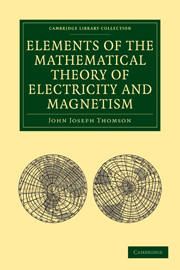Book contents
- Frontmatter
- PREFACE TO FIRST EDITION
- PREFACE TO THE SECOND EDITION
- PREFACE TO THE THIRD EDITION
- PREFACE TO THE FOURTH EDITION
- Contents
- CHAP. I General Principles of Electrostatics
- CHAP. II Lines of Force
- CHAP. III Capacity of Conductors. Condensers
- CHAP. IV Specific Inductive Capacity
- CHAP. V Electrical Images and Inversion
- CHAP. VI Magnetism
- CHAP. VII Terrestrial Magnetism
- CHAP. VIII Magnetic Induction
- CHAP. IX Electric Currents
- CHAP. X Magnetic Force due to Currents
- CHAP. XI Electromagnetic Induction
- CHAP. XII Electrical Units: Dimensions of Electrical Quantities
- CHAP. XIII Dielectric Currents and the Electromagnetic Theory of Light
- CHAP. XIV Thermoelectric Currents
- CHAP. XV The Properties of Moving Electric Charges
- INDEX
CHAP. III - Capacity of Conductors. Condensers
Published online by Cambridge University Press: 07 September 2010
- Frontmatter
- PREFACE TO FIRST EDITION
- PREFACE TO THE SECOND EDITION
- PREFACE TO THE THIRD EDITION
- PREFACE TO THE FOURTH EDITION
- Contents
- CHAP. I General Principles of Electrostatics
- CHAP. II Lines of Force
- CHAP. III Capacity of Conductors. Condensers
- CHAP. IV Specific Inductive Capacity
- CHAP. V Electrical Images and Inversion
- CHAP. VI Magnetism
- CHAP. VII Terrestrial Magnetism
- CHAP. VIII Magnetic Induction
- CHAP. IX Electric Currents
- CHAP. X Magnetic Force due to Currents
- CHAP. XI Electromagnetic Induction
- CHAP. XII Electrical Units: Dimensions of Electrical Quantities
- CHAP. XIII Dielectric Currents and the Electromagnetic Theory of Light
- CHAP. XIV Thermoelectric Currents
- CHAP. XV The Properties of Moving Electric Charges
- INDEX
Summary
51. The capacity of a conductor is defined to be the numerical value of the charge on the conductor when its potential is unity, all the other conductors in the field being at zero potential.
Two conductors insulated from each other and placed near together form what is called a condenser; in this case the charge on either conductor may be large, though the difference between their potentials is small.
In many instruments the two conductors are so arranged that their charges are equal in magnitude and opposite in sign; in such cases the magnitude of the charge on either conductor when the potential difference between the conductors is unity is called the capacity of the condenser.
If the difference of potential between two conductors, produced by giving a charge + q to one conductor and - q to the other, is V, then q/V is defined to be the capacity between the conductors.
52. Capacity of a Sphere placed at an infinite distance from other conductors. Let α be the radius of the sphere, V its potential, e its charge, the corresponding charge of opposite sign being at an infinite distance. Then (Art. 17), the potential due to the charge on the sphere at a distance r from the centre is e/r; therefore the potential at the surface of the sphere is e/α.
- Type
- Chapter
- Information
- Publisher: Cambridge University PressPrint publication year: 2009First published in: 1895

